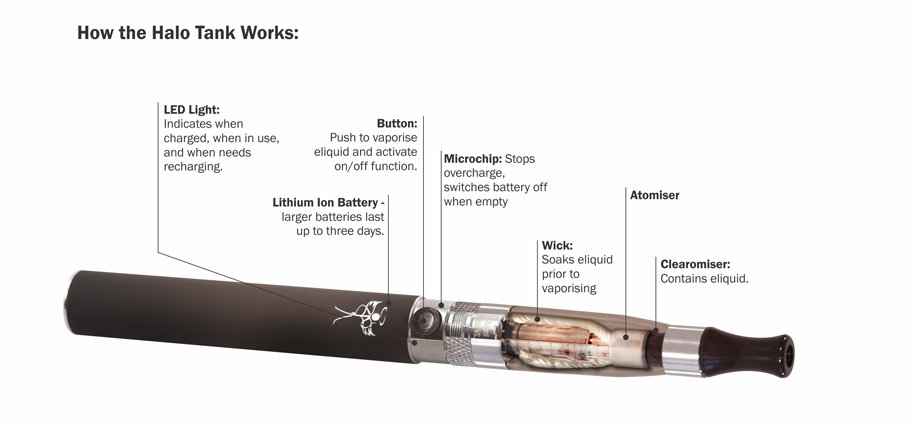 |
| How does it work?? |
Electronic cigarettes, also known as smokeless cigarettes, e-cigarettes, or e-cigs, are an alternative method of consuming nicotine, the addictive chemical found in tobacco. Manufacturers often design e-cigarettes to look like regular cigarettes, but they contain no tobacco and don't require a match -- or any flame at all.
An e-cigarette is a battery-powered device that converts liquid nicotine into a mist, or vapor, that the user inhales. There's no fire, no ash and no smoky smell. E-cigarettes do not contain all of the harmful chemicals associated with smoking tobacco cigarettes, such as carbon dioxide and tar.
Manufacturers and satisfied customers say the e-cigarette is a healthier alternative to tobacco cigarettes, which cause millions of deaths every year. Some users say e-cigs have helped reduce their "smoker's cough," sharpened their senses of taste and smell, and even improved their sleep.
The e-cig was invented by Chinese pharmacist Hon Lik, who patented the device in 2003 and introduced it to the Chinese market the following year. Numerous companies are now selling e-cigarettes to customers around the world. But as e-cigarette smoking -- or "vaping" as it's sometimes called -- has grown in popularity, some have concerns about its safety, including the possibility that the vapor created by the devices might contain dangerous chemicals.
Using an Electronic Cigarette
Lighting a normal cigarette causes the tobacco to burn, releasing smoke that contains nicotine. The user inhales the smoke to deliver the nicotine to the lungs. An electronic cigarette doesn't rely on this process of combustion. Instead, it heats a nicotine liquid and converts the liquid to a vapor, or mist. Depending on the e-cigarette, the user may simply inhale from the cartridge to begin the vaporization process or a manual switch that activates the vaporizer inside.
An e-cigarette has three main parts:
- a rechargeable lithium battery
- a vaporization chamber
- a cartridge
The lithium battery powers the e-cigarette and can be charged using a charger similar to those used for cell phone batteries. The charged battery is connected to the vaporization chamber, a hollow tube that contains electronic controls and an atomizer -- the component that creates the vapor. Before the user activates the device, he or she attaches a cartridge containing nicotine liquid to the vaporization chamber.
E-cigarette users inhale the way they would with a regular cigarette. This inhalation activates the atomizer to heat the liquid in the cartridge and convert the liquid to a vapor. Inhaling this vapor through the mouthpiece delivers nicotine to the lungs, and the user exhales vapor that looks much like a cloud of cigarette smoke.
Fans of e-cigarettes say they enjoy many of the same sensations as tobacco smokers -- holding the device in their hand, inhaling and exhaling. Many e-cigarettes have a light-emitting diode (LED) on the end that lights up when the user inhales, simulating flame. (Artificial flame is the only safe kind when using an e-cigarette -- trying to light the device could cause the battery to ignite and explode.)
The liquid or "smoke juice" that fills the cartridges is usually propylene glycol, an additive that the FDA has approved for use in food. (Fog machines that create a smoky atmosphere at stage shows also use propylene glycol.) Consumers can buy cartridges containing different amounts of nicotine, or no nicotine at all. Manufacturers usually add flavorings to the liquid. Options range from tobacco and menthol flavor to mint, chocolate, coffee, apple, cherry and caramel.
is usually propylene glycol, an additive that the FDA has approved for use in food. (Fog machines that create a smoky atmosphere at stage shows also use propylene glycol.) Consumers can buy cartridges containing different amounts of nicotine, or no nicotine at all. Manufacturers usually add flavorings to the liquid. Options range from tobacco and menthol flavor to mint, chocolate, coffee, apple, cherry and caramel.
E-cigarette companies sell their products in retail stores, but also, increasingly, online. A wide array of models and brands are available. Some mimic the appearance of tobacco cigarettes, while others look like cigars, pipes and even pens. Prices vary, ranging from $40 to $120 for a starter kit, which usually includes a charger and a few cartridges along with the e-cigarette. Cartridges typically last about as long as a pack of 20 tobacco cigarettes and sell for about $10 each. Consumers also can purchase bottles of e-liquid and refill the cartridges themselves. This reduces the cost of use, generally making e-cigarettes cheaper to use than tobacco cigarettes.
in retail stores, but also, increasingly, online. A wide array of models and brands are available. Some mimic the appearance of tobacco cigarettes, while others look like cigars, pipes and even pens. Prices vary, ranging from $40 to $120 for a starter kit, which usually includes a charger and a few cartridges along with the e-cigarette. Cartridges typically last about as long as a pack of 20 tobacco cigarettes and sell for about $10 each. Consumers also can purchase bottles of e-liquid and refill the cartridges themselves. This reduces the cost of use, generally making e-cigarettes cheaper to use than tobacco cigarettes.

